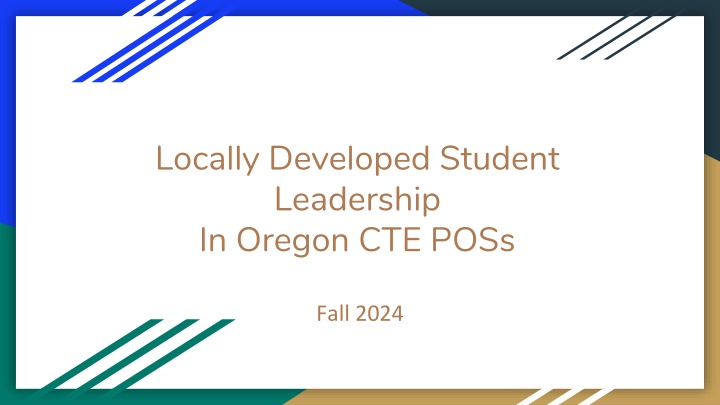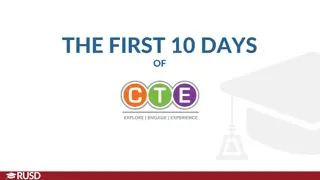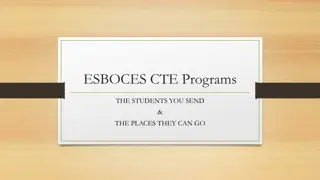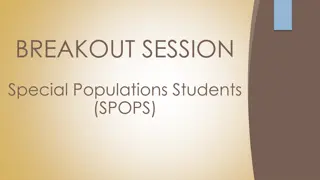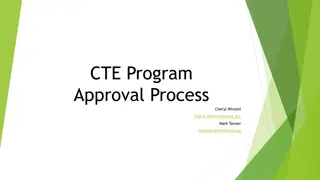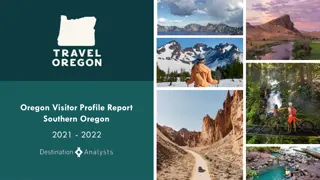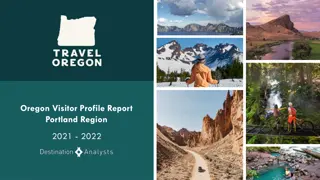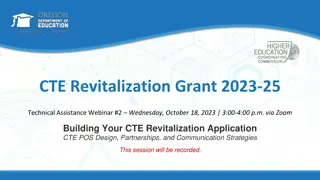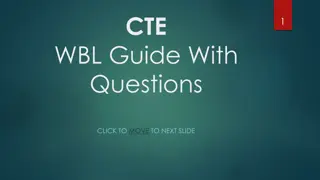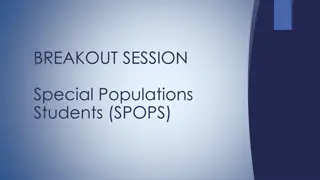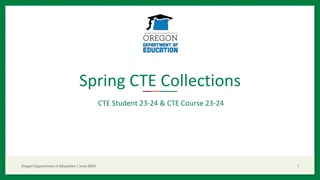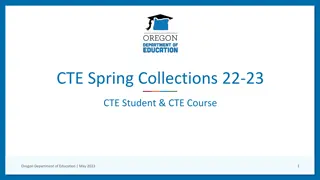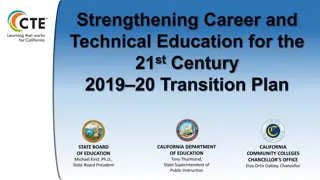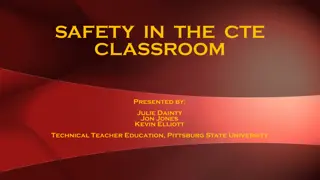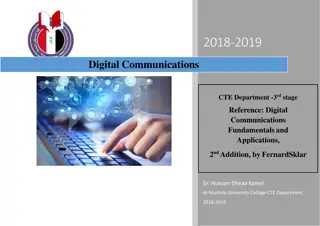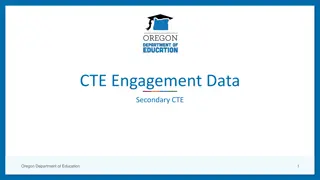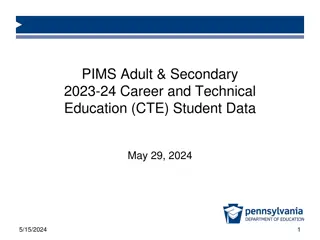Locally Developed Student Leadership in Oregon CTE Programs
Significance of student leadership in Career Technical Education Programs of Study (CTE POS) in Oregon. Delve into the criteria, benefits, and opportunities provided by student leadership structures within CTE programs.
Download Presentation

Please find below an Image/Link to download the presentation.
The content on the website is provided AS IS for your information and personal use only. It may not be sold, licensed, or shared on other websites without obtaining consent from the author.If you encounter any issues during the download, it is possible that the publisher has removed the file from their server.
You are allowed to download the files provided on this website for personal or commercial use, subject to the condition that they are used lawfully. All files are the property of their respective owners.
The content on the website is provided AS IS for your information and personal use only. It may not be sold, licensed, or shared on other websites without obtaining consent from the author.
E N D
Presentation Transcript
Locally Developed Student Leadership In Oregon CTE POSs Fall 2024
Why student leadership? Question? What is there about student leadership that has made it nationally a big part of CTE expectations?
What is student leadership? Definition: Student leadership opportunities are an integral piece of the secondary component of Career Technical Education Programs of Study (CTE POS). A student leadership structure within a CTE POS provides leadership development opportunities that meet the following expectations: 1. Instruction, Career Development, and Assessment based on CTE Skill Sets 2. Community-based connections 3. Organizational Participation/Administration/Leadership opportunities
Why student leadership? (part 2) CTE: Preparing students for their next step Education Higher Education, trade school, military, others Career knowledge and skills for success: entry to advancement Life roles (Learner, Producer, Consumer, Citizen, Individual, Family Member) (These roles were determined by the Oregon State School Board in the 1980 s) Benefits of student leadership for students Context for learning Bridges academic world to the real world Gives student a sense of belonging Provides opportunities for positive interaction with adults/practitioners
CTE Student Leadership Organizations Criteria for Locally Developed Student Leadership/CTSOs Student leadership opportunities are an integral piece of the secondary component of Career Technical Education Programs of Study. A student leadership structure within a CTE Program of Study provides leadership development opportunities that meet the following expectations: 1. 1 Delivery mechanism for career area content (tied to skill sets) 2. 2 Community connected (including WBL, Project Based Learning, etc.) 3. 3 Enterprise management and membership (member, leader, meeting process) (the full text of the Criteria document is available on the ODE CTSO website)
CTSO versus Locally Developed Student Leadership State-recognized CTSOs: DECA (Marketing) FBLA (Business Management and Administration) FCCLA (Child Development, Education) FFA (Agriculture) FNRL (Natural resources) HOSA (Health sciences) SkillsUSA (Engineering, Construction, Automotive, and other trades, etc.) TSA (Technology and Electronics)
CTSO versus Locally Developed Student Leadership (part 2) Making a choice 1. State Board recognized CTSO or 2. Locally Developed Student Leadership opportunities
Why Decide to Offer a Locally Developed Student Leadership Opportunity? Thought partners: What are some reasons to not have a CTSO in your POS? or What are some benefits for having locally developed student leadership?
So What do you need to have in place for a Locally Developed Student Leadership opportunity? The three large criteria 1. Tied to curriculum (Skill Sets) 2. Community connections with business and/or industry practitioners 3. Organizational membership, process, and leadership
1. Co-curricular (tied to Skill Sets) Helps teach toward skill sets Not just a cookie & milk club Delivery of knowledge and skills Opportunities for student to demonstrate K&S School-based enterprises and learning/demonstration labs (WBL) Possible IRCs
2. Community connected (project based) Working with community partners Community members on advisory board Help with POW and design of calendar/agenda Mentorships/internships Service learning Identify/design projects Community needs Community contacts Communications Evaluation of projects
3. Enterprise management and membership Membership experience for student Leadership experiences for students Opportunities for networking Instruction on organizational processes and procedures Develop an organization s Plan of work Designing and following agenda (meetings) Parliamentary procedure/rules of order Financial strategy instruction
Note: Financial strategy instruction Understand basic financial concepts Understand rules and laws regarding enterprise finances Help with the cash flow of an organization Adhere to financial ethics
CTE-IS application (part 6) 1. Curriculum, teaching, and workplace experiences will reflect the Oregon Skill Sets for the Marketing Cluster. Instruction will be focused on internal and external sales, as well as market research Program design, implementation, and evaluation is done collaboratively with local business and industry partners engaged with students. Those partners also provide external opportunities for students to work with the community on projects connected back to the POS curriculum Students meet twice each month, following Robert's Rules of Order to conduct meetings that follow student-developed agendas. Students each take turns at leading initiatives, projects, and the operation of the chapter itself 2. 3.
Resources: Student Leadership Expectations CTSO Board Approval Process Oregon Skill Sets Tri Leadership Resources TEACH CTSO These slides
Questions ?? Thank you! Ron Dodge (ron.dodge@ode.oregon.gov)
